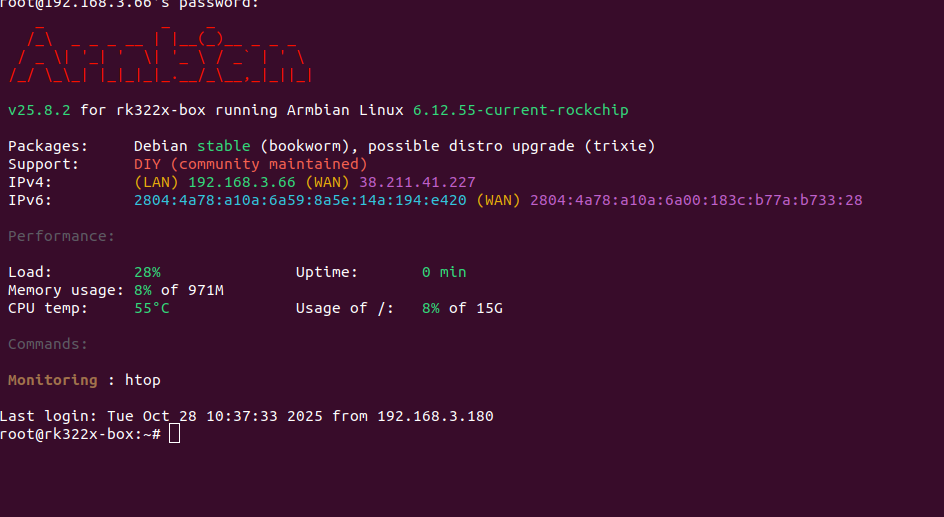All Activity
- Past hour
-
@Virgilio Junior you can use multitool, and use the "jump start" installation: you should be able to boot from sdcard and USB as well without doing the process by hand. Forget about the NAND, it causes troubles you would not deal with
-
I have an 8gb pendrive, I think I'll follow the process: Putting u-boot via rkdev and booting via pendrive is something I won't miss!
-
@Virgilio Junior None newer of 4.4.xxx ( usually 4.4.194) Will let you use internal nand You should spray on sd
- Today
-
I have seen kernel updates for my system since you began this thread. You could check for a latest update, and see if the issue self-corrects. Do you know when the latest zfs-dkms package was updated? Perhaps it's just getting too out of sync with the kernels. If all else fails, you can build the kernel yourself: https://docs.armbian.com/Developer-Guide_Build-Preparation/ ...and in the kernel config, be sure that zfs modules are included. From the kernel config screen, you can do a search for zfs, and see what comes up. If there are zfs modules available there, this would be a different approach that would probably replace the use of the zfs-dkms package.
-
Thank's for your prompt reply. Attached, you'll find the logs. SD boot fails with Armbian image on SD : bootlogM5Armbian.log SD boot success with ubuntu 20.4 (provided by BPI site) on SD : bootlogM5BPIUbuntu.log Regards Guy bootlogM5Armbian.log bootlogM5BPIUbuntu.log
-
By some miracle of faith, yesterday at the last second before I gave up, I simply put Armbian_24.2.5_Rk322x-box_bookworm_current_6.6.22_minimal.img directly onto the SD card, and incredibly it loaded and I can use everything smoothly on the RK3229 (R329Q_V3.1), including running it on 5.0ghz Wi-Fi... but now the question is, can I put it on the NAND card? If it's not worth it, I'm thinking of leaving it on my SD card, then I'll buy other SD cards for my Raspberry Pi 1 b+ and another TV box I have (I haven't seen the card yet). I'm building a minilab. actually minilab(not working again) A computer with an AMD A4-4000 + 8GB RAM with Proxmox. A Raspy with Dietipi, Pihole, and Adguard. A TVBox-1 for observability (Grafana stack). A TVBox-2 to act as a redundancy node for TVBox-1 and a test server. Speaking directly, I took the image and ran the commands I saw on some postmarketos forums about recording directly via rkdev: rkdeveloptool wl 0x0 rockchip-rk322x-exemple.img
-
Oh, okay. I'm not familiar with DKMS. But if you're updating multiple packages at once, doesn't apt sort out which need to be done first and second, etc? But if you're somehow rebuilding the kernel upon package installation, I'd install the headers package first - as those would be required for source-code level access. As for the devicetree blobs package, that just provides copies of those (already build) .dtb files to your /boot directory. But they're actually already included in the kernel package itself. The kernel package installs them to: /usr/lib/linux-image-_______/ So on my Orange PI 5 Plus, the dtb directory from the latest kernel package is here: /usr/lib/linux-image-6.18.0-rc3-edge-rockchip64/ Keeping the convention Armbian uses, instead of installing the redundant dtb package, I manually create two links to it in my /boot directory whenever I update the kernel (I have to do this for Debian-sourced kernels anyway): cd /boot ln -s /usr/lib/linux-image-6.18.0-rc3-edge-rockchip64 dtb-6.18.0-rc3-edge-rockchip64 ln -s /usr/lib/linux-image-6.18.0-rc3-edge-rockchip64 dtb Just replace that kernel with whichever one you're using. And if you're booting via uboot, be sure the Armbian.txt remains up to date.
-

mxq pro 4k 5g allwinner h313 can't sd card boot
Gallahad replied to Ducdanh Nguyen's topic in Allwinner CPU Boxes
i too am facing this problem, i bought this box for round 1500 inr with armbian in mind i thought it would be h3 but it was h313 and then i also noticed that the fonts looked different on the soc, well here i am. the main purpose for this purchase was installing armbian to run home assistant server but that aint gonna happen and raspberry pi's and other alternatives are too expensive still not what i bought it for but yeah gotta live with it now btw any updates on this -
@Virgilio Junior R329Q_V3.1 are known board to be a little "difficult" to manage, but they work and work very well because are ddr3 up to 660 mhz ram speed The big problem is that they are mostly NAND thus support is limited to legacy old images with kernel 4.4.194 and NAND support any newer kernel simply will not boot because of NO NAND DRIVERS I said MOSTLY because lately have shown on the market borads 329 with ecmp and i don't know if yours is this with ecmp would you explain in a more detailled way what you did, please ?
-
debug boot issues and provide logs: https://debug.armbian.de
-
Hi, everybody, I have 2 M5 one running Debian Server and one running ubuntu Desktop. Both images downloaded from BPI site and Installed on EMMC. I want to replace these OS with armbian server. I tried armbian v6.12 (Ubuntu KDE 24.04, Ubuntu Server 24.04 and Minimal IOT). None of them boot from SD card. The Ubuntu 20.4 image downloaded from BPI site boot well from SD card. I have restored the original Android image with Amlogic burnin tool on one M5 and Armbian don't boot from SD but the ubuntu 20.4 from BPI site works well. I don't known what to do ? Thank's in advance
-
Hello community Here are the versions I’m using: Kernel: 5.15.48-sunxi OS: Linux nanopineo 5.15.48-sunxi #22.05.3 SMP Wed Feb 19 15:56:03 UTC 2025 armv7l GNU/Linux I’m having a problem. Sometimes, during boot, I see the following log: After this message, the system halts. The only way to fix it is to flash the image again or to boot from an SD card and mount the EMMC which fixes the file system. I noticed that the device doesn’t use the overlay_prefix variable from /boot/armbianEnv.txt. It shows this message: I tried adding the overlay_prefix variable manually in the boot.cmd file, but it didn’t help. Previously, I changed: to Could that be the cause? I changed it back to default but the problem still happens. Do you have any ideas what could be wrong?
-
Some modules are not included in the kernel package by default. In my case I had to install zfs-dkms built upon Dynamic Kernel Module Support(DKMS). The module gets rebuilt whenever I upgrade the kernel—I'm not sure exactly which package I have to upgrade first though, header? dtb? Somehow the zfs module was not successfully built after I upgraded the kernel, its header files, and the device tree blobs.
-

Run dkms after armbian-upgrade
Marcos Alano replied to Marcos Alano's topic in Software, Applications, Userspace
I think it's easier than that. I looked into the postinst file for kernel headers on my Ubuntu machine, and I found this: #!/bin/sh set -e version=6.17.0-7-generic if [ "$1" != configure ]; then exit 0 fi if [ -d /etc/kernel/header_postinst.d ]; then DEB_MAINT_PARAMS="$*" run-parts --report --exit-on-error --arg=$version \ /etc/kernel/header_postinst.d fi exit 0 The postinst script for the headers package doesn't have anything similar, so we should add it this part related to execute the scripts under `/etc/kernel/header_postinst.d`. Can you do that or should we add someone else to the discussion? EDIT: Debian does something similar. Same goal, just a different code: #!/bin/sh -e version=6.12.48+deb13-amd64 linux-run-hooks headers postinst $version -- "$@" exit 0 -

Run dkms after armbian-upgrade
Werner replied to Marcos Alano's topic in Software, Applications, Userspace
Perhaps package dependencies need to be adjusted so the installation order matches the requirements? Cannot help there though, I have very little insight. -
Yes That's on us
-
@Jeeva Kandasamy it’s on this page https://github.com/NickAlilovic/build/tree/v20250306
-

Run dkms after armbian-upgrade
Marcos Alano replied to Marcos Alano's topic in Software, Applications, Userspace
Hi @Werner It seems the problem is in another place. The unattended upgrade updates the kernel, but the dkms hooks are not installed. I just got a couple kernel updates, and neither of them ran the DKMS, and since I'm using ZFS, it causes serious problems since the ZFS module wouldn't be build, so after a reboot wouldn't load and I couldn't access the data in my disks. I don't think adding the command to `armbian-upgrade` would solve since `apt upgrade` would still have the problem, and also the unattended upgrades, like mentioned before. Any ideas? EDIT: I found the problem, but couldn't find a solution. What is happening, is the kernel package is updated first, so actually it calls the dkms hook, but the headers wouldn't be installed, at least the latest version, yet, so the dkms can't run. The problem is how to install the headers before the kernel, or call the dkms hook from the headers package, so even if the kernel calls dkms but can't run because of the lack of updated headers, the headers will do that and succeed. -
Thanks for the details @Nick A I tried with fedora/docker Can you please share the OS details, originally build OS and "./compile" options for https://github.com/NickAlilovic/build/releases/download/20250306/Armbian-unofficial_25.05.0-trunk_X96q-ddr3-v5-1_bookworm_edge_6.12.11_server.img.xz
-
Latest compile for odroid xu4 does have a desktop. Any reason why?
-
Okay, thanks for the explanation! So, I got Armbian compiled and running by just adding the .dts file and the .csc file. The .csc file is a copy of the ODROID M1 .config file, but with some modifications: I threw out the SPI-related stuff, because the M1S does not have a SPI flash to boot from and it gave me arrors during compilation. I tested basic functionality with a Ubuntu Noble Cinnamon desktop image as well as a headless server image. Is this enough to create a pull request? How is the Download page created? Is that made by the Armbian team or do I need to add it there as well (how?) ? Greetings
-
Same answer and further reasoning as here:
-
better in which way? performance? driver support? size? from our pov the better the support conditions, the more likely to recommend. https://www.armbian.com/download/?device_support=Standard support Is one platinum? Go for it? If not, check standard support. If one is in this category, go for it. If not, check further down for community support.
- 1 reply
-
- Orange Pi 5 Pro
- Orange Pi 5 Max
-
(and 2 more)
Tagged with:
-
Yes. In the past everything was added as patch. The problem was (and still is for other reasons) that some patches modifying a dt build on top of each other or stuff breaks. Now the dt can be edited directly and using git blame it is documented who edited what for whatever reason. Of course sometimes there is an almost perfect dt upstream that needs minor adjustments. Those can be perfectly fine done with a patch. Also both patches and our dt files only stay for as long as there is no proper equivalent upstream. Once everything is in mainline they are no longer needed.








